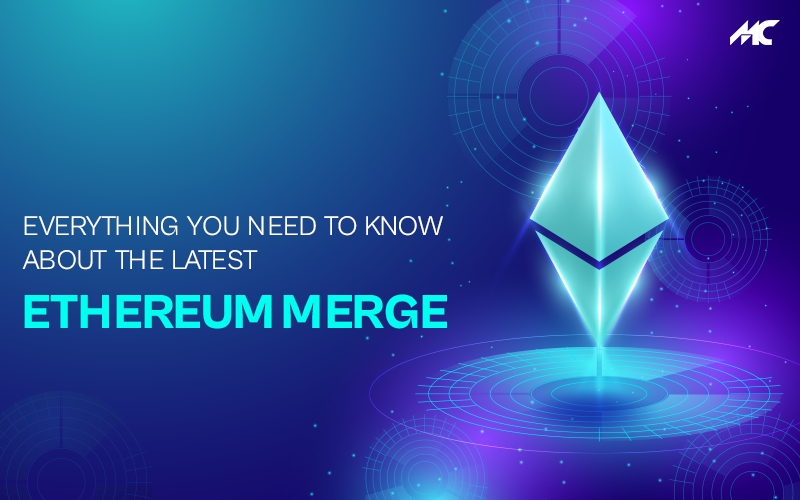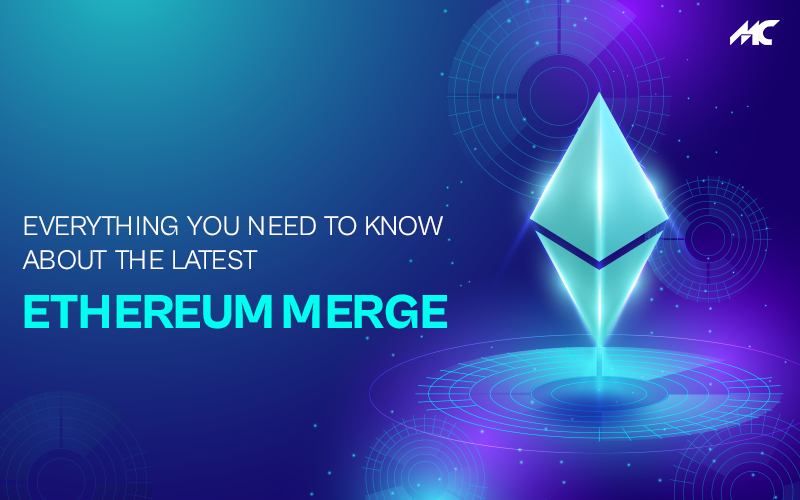Everything You Need to Know About the Latest Ethereum Merge
On September 14, 2022, Ethereum officially got updated to ‘Proof of Stake.’ This movement of joining PoS is now known as Ethereum Merge and was taken in response to the guzzling energy requirements of the Ethereum Blockchain.
Previously, this Blockchain used to consume the same amount of energy as the entire nation of Chile. Even environmentalists had criticized the electricity-intensive method of minting in the ‘Proof of Work’ model and its massive impact on the environment in the era of climate change and global warming.
In this blog, we are going to discuss everything you need to know about the latest Ethereum Merge.
Key Takeaways from the Ethereum Merge That You Should Know
- Ethereum Merge is the smooth transition of the consensus system from Proof-of-Work (POW) to Proof-of-Stake (POS).
- It is expected that this transition of consensus mechanism will result in reducing 99% of energy costs related to Ethereum transactions.
- The ecosystem will be moving from the current Ethereum Mainnet to the new Ethereum Beacon Chain.
- The Ethereum Merge was scheduled on September 15, 2022.
What is Ethereum Merge?
It took 8 years of preparation for Ethereum to finally adopt the Proof of Stake model. Ethereum Merge is the shift from legacy POW to POS system. As a result, now the energy consumption levels will drop by 99%, and scalability will be a lot easier with Ethereum Merge. Lastly, this new Ethereum ecosystem is known as Ethereum 2.0.
The shift to a new consensus model will need staking and locking up. Therefore, the Ether tokens of the ecosystem will remain the same for the investors and stakeholders. However, it might open up new opportunities for Blockchain development.
The operations of the Ethereum-based applications will also remain exactly the same. However, during the Merge process, the users might not be able to transfer their Ethereum-based assets.
Before we understand the details of Ethereum Merge, it is important to learn the difference between Proof-of-work and Proof-of-stake.
Understanding PoW and PoS

Both methods are ideal for validating cryptographic transactions on a Blockchain network. These two components of Blockchain technology are very important for cryptocurrency transactions and security.
They help in ensuring that the users are honest with the transactions and make it super hard and expensive for bad actors on the Blockchain. Therefore, both are important systems for reducing frauds like double-spending.
What is Proof-of-Work?
Proof-of-Work (POW) is a decentralized consensus ecosystem that requires huge computational power. Moreover, it was the original crypto consensus mechanism that was first used by the Bitcoin cryptocurrency.
Virtual miners play a significant role in verifying the transactions on a Blockchain by solving complex mathematical puzzles. The first person to solve the math puzzle to verify transactions is then rewarded automatically with a determined sum of crypto.
This consensus mechanism is a very powerful method of verifying transactions. Plus, it is also being used by leading cryptocurrencies like Bitcoin and Ethereum (till now). Therefore, it is a very robust approach to securing a decentralized Blockchain. With the increasing value of cryptocurrencies, more miners are getting incentives to join the network. Their contribution is very useful for the Blockchain to improve its security and power.
However, Proof-of-Work is a very energy-intensive process. Therefore, it can lead to severe environmental impact and trouble in scaling to verify a large number of transactions. This was the major reason behind the Ethereum Merge.
What is Proof of Stake?
The Ethereum Foundation knew the potential limitations of the Proof-of-Work consensus mechanism from the inception of its Blockchain. In fact, they had a clear idea about the scalability issues that would come in the future with the growing popularity of the Ethereum platform.
The rapid growth of decentralized finance (Defi) has also made the Blockchain struggle while keeping up with the demand. As a result, they had to increase the transaction fees to sustain the Blockchain.
The Proof-of-Stake system has similar functionality to Proof-of-Work’s mining. It also requires a network participant to add and verify a batch of transactions on the Blockchain to receive some crypto as incentives.
A Blockchain with a Proof-of-Stake mechanism requires a network of ‘validators’ who will be responsible for contributing or staking their own crypto to get the chance to validate new transactions, make updates to the Blockchain, and earn incentive rewards.
Workflow of Proof-of-Stake System
- The Blockchain network will select a winner based on the sum of crypto each participant has in the pool and the duration of time they’ve had it in their possession. Therefore, this system rewards the most invested participants.
- Once the winning participant has validated the latest block of transactions, other participants can ensure that the block is genuine and accurate. When a considerable number of attestations are made, the Blockchain will get updated.
- All the participants in the validation process get a reward in the form of a native cryptocurrency. This amount is distributed to participants of the network depending on their stake.
Proof-of-Work Vs. Proof-of-Stake
In order to understand the difference between Proof-of-Work and Proof-of-Stake, this comparison will help you out;
Importance of POS for the Ethereum Blockchain
While the Blockchain of Bitcoin is usually used for processing the flow of Bitcoin transactions. Ethereum’s Blockchain is responsible for processing a wide variety of Defi transactions, NFT minting, stablecoin smart contracts, and a lot more.
Basically, the Ethereum Blockchain provides limitless possibilities to developers. For these extensive use cases, the implementation of Proof-of-Stake was important to ensure a less resource-intensive and faster consensus mechanism. Ultimately, the main goal behind Ethereum Merge was to maximize the speed and overall efficiency while reducing the fees.
Vitalik Buterin, the creator of the Ethereum Blockchain, already said in a YouTube Livestream that this is the first major step in Ethereum’s big journey to becoming a very mature system. However, there are still a lot of things to improve in the Ethereum ecosystem, such as privacy concerns.
What is Ethereum 2.0?
Ethereum 2.0, also popularly known as the Eth2, will be the Blockchain’s new name after the consensus process shift. After completing the update to Eth2, the Blockchain will be able to avoid bottlenecks and security flaws and process a higher number of transactions.
The Beacon Chain was launched in 2020 as the Proof-of-Stake mechanism for the Blockchain network. This chain will become fully operational for the Blockchain once the Ethereum Merge is finally live. Moreover, it will function as the controller of the new network of Ethereum and will also manage every process of the PoS protocol.
ETH vs. ETH2: Clearing the Misconceptions
ETH2 is not a new cryptocurrency itself; instead, it just refers to the latest Proof-of-Stake system or network that will support the Ethereum Blockchain. ETH will continue to remain the only native cryptocurrency of the Ethereum Blockchain. You don’t need to get into confusion by thinking about ETH2 as a new cryptocurrency.
Effect of Ethereum Merge on Investors
Although the Ethereum Merge won’t be providing instant benefits in the form of a faster network or lower transaction costs. However, the investors are likely to see benefits in the long term.
The Ethereum Merge will lay the foundation for future upgrades in terms of speed, scalability, feed, innovation, and development. Moreover, faster transactions and lower fees can eventually attract more users and investors to the Blockchain. It might also have an impact on the value of Ethereum’s native cryptocurrency.
The increasing number of investors might decrease the supply of Ether in the long run. With the decrease in Ether supply, the value of the cryptocurrency will shoot up. This would be a piece of great news for the potential investors who might invest in this platform.
What Will be The Environmental Impact of the Ethereum Merge?

The Ethereum Merge will be a massive relief for the environment. In fact, we can expect a reduction in energy consumption by up to 99% with this shift from PoW to PoS. Before this shift, Ethereum’s carbon emissions were the highest, along with some other prominent Blockchain networks.
The latest shift toward the Proof-of-Stake mechanism would be an attractive aspect for environmentally conscious investors. Moreover, it could even contribute to reducing Global Warming.
It Might End the Role of Miners
The original Bitcoin network introduced in 2008 focused on an idea of a decentralized ledger. This idea focuses on having a single immutable record of transactions. Any participant of the Bitcoin Blockchain would be able to access this record without having the need for intermediaries.
Ethereum also works on the same idea as Bitcoin. It also used Smart Contracts and computer programs that would connect the world a create a global record for data. This innovative approach also led to the birth of NFTs and decentralized finance (Defi).
The Ethereum Blockchain is responsible for empowering a lot of industries apart from just the finance industry. Therefore, this also gave birth to miners who were responsible for consuming energy to validate the transactions on the Blockchain.
The end of the Proof-of-Work system might also mean the end of miners who competed against each other to verify the transactions on the ledger. Now it all depends on the stake one is willing to take in the Ethereum ecosystem.
The constant growth of the current Ethereum ecosystem also meant the rise of competition between the miners. Thus, mining became incredibly hard with the Proof-of-Work approach. Today, crypto mining is mostly done on huge farms consisting of tons of computers that solve cryptographic puzzles. This legacy system was actually an ideal solution for the Bitcoin miners who spent thousands of dollars buying the best computer hardware for mining purposes.
However, building such farms for mining was never a good step for the environment. Not only did it create a significant increase in energy consumption, but it also gave birth to the problem of rising e-waste and expensive computer hardware. Therefore, this was only leading the Ethereum ecosystem to become a toxic environment narrative. The gradual shift towards the POS system would mean the end of Ethereum miners and good news for the environment.
The Rise of Stakers
Ethereum’s new system of Proof-of-Stake is drastically changing the transaction validation process. For this reason, the miners are completely fading away from the Ethereum ecosystem, while stakeholders now have incredible opportunities.
The validators or stakeholders will play a major role in verifying each transaction on the Blockchain. Each validator needs to ‘stake’ at least 32ETH on the Ethereum Network. Here, these cryptographic tokens cannot be bought or sold.
We can say that these staked tokens will work like lottery tickets for the stakeholders on the Blockchain. Therefore, by having higher stakes in the network, they are more likely to get the opportunity to write a ‘Block’ present on the digital ledger. In this way, the stakeholders will have a prominent role in the proper functioning of Ethereum.
This concept of Proof-of-Stake for the Ethereum Blockchain isn’t new. In fact, the Beacon Chain (chain behind POS) was first introduced by Ethereum in 2020. However, this waited until validators were ready for the switch to Merge. It will ensure the effective transition to Proof-of-Work in the Ethereum network.
The Potential Risks of Ethereum Merge

Crypto experts have already discovered several risks with the Ethererum Merge. In fact, this is the biggest update that ever took place in a crypto Blockchain network to date. These are some of the risk factors that might impact Ethereum Merge:
1. DoS (Denial-of-Service) Vulnerability
With the shift towards a PoS model, the Blockchain network might be susceptible to a denial-of-service attack. For instance, a potential attacker waiting in line to propose the next block in the Blockchain can launch a DoS attack on the current proposer’s node resulting in them losing their slot. Ultimately, the transactions present in the slot will be picked up by the attacker. However, the Ethereum Foundation is already in the talk to make the proposer section anonymous.
2. Staking in ETH Might Result in Centralization
Staking in a Blockchain is not limited to an individual level. In fact, investors are taking a huge interest in Staking pools. These pools have become the ideal solutions for investors who don’t have the needed 32 Ether to participate in the Blockchain. They can use these groups of investors to raise funds to become a validator on the network. Therefore, centralized entities can play a major role in influencing the validators working on the nodes. Ultimately, this might lead to censorship or governance takeover of the Ethereum Blockchain.
3. New Scams
People are still unaware of the ETH2. Thus, many crypto wallets and applications are referring to the Merge as an entirely new platform. Whereas, ETH2 is misinterpreted as a newly formed cryptocurrency. However, in reality, the cryptocurrency, Ether, is still the same on the Ethereum Blockchain. Scammers might take advantage of this confusion by asking users to upgrade their ETH coins to ETH2 coins. However, in reality, they would be only stealing the Ethers from the users.
4. There Could be ETH Price Drop
Not everyone is still ready for the Merge; plus, we have also discussed some potential risks of the Ethereum merge. Therefore, this could lead to a sudden price drop of Ether and also other cryptocurrencies which are based on the Ethereum Blockchain.
Why it Took So Long to Implement Ethereum Merge?
The Ethereum Foundation had already planned to implement Ethereum Merge around 2 years ago. In fact, they had already developed the Beacon Chain for enforcing this new consensus method. However, it isn’t possible to forcefully push all the users to the new chain.
To solve this problem, they had also coded a “difficulty bomb”, a computer program that will make the ETH mining process much harder until they connect to the new Beacon Chain. However, such drastic measures could have catastrophic implications on the entire crypto economy.
In fact, any mismanagement of time and processes can lead to the collapse of the entire network. As a result, a lot of people can lose their investments and NFTs present on the Ethereum Blockchain. Thus, the developers of Ethereum took enough time to encourage people to prepare for the massive merge.
Moreover, Ethereum will also suspend all the transactions on the Blockchain an hour before the Merge. This would reduce the risk of disruption and disputes.
How the Merge Was Executed?
Ethereum’s “Bellatrix” update was introduced on September 6, 2022. This update is meant for preparing the Beacon Chain technology to adopt the broader network.
Next, the developers had to work on unlocking the entire Ethereum network to solve all the minded blocks. After this, the Ethereum Merge execution with Beacon Chain will be finally completed. Ultimately, this process will force all its users to use Beacon Chain.
The Future of Ethereum Blockchain
The shift from PoW to PoS will be a drastic change in the Ethereum ecosystem. Every application and cryptocurrency (based on Ethereum) will get affected by this transformation. Moreover, this is a very positive change for the conservation of our environment.
-

 Mobilecoderz Awarded as India’s Best iPhone App Development Company by Clutch
Mobilecoderz Awarded as India’s Best iPhone App Development Company by Clutch -

 How Much Does It Cost to Develop a SaaS Application?
How Much Does It Cost to Develop a SaaS Application? -

 Mobilecoderz recognized as the Top App Development Company in Saudi Arabia by GoodFirms
Mobilecoderz recognized as the Top App Development Company in Saudi Arabia by GoodFirms










